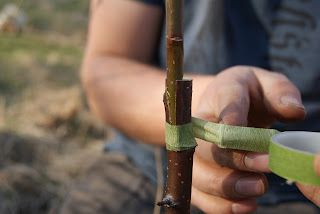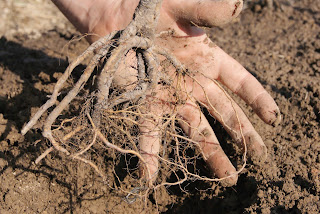In the flat, our trays of suspended seedlings are starting to sprout (only the peppers seem intent upon hiding in the earth a little longer) and the Berner Rose Tomatoes now occupy every available window space on sills and in between panes planted out in their paper pots.
Out on the farm, everything is beginning to come alive. Daffodils and crocuses radiate from unexpected corners and the trees are bustling with tiny green shoots and swelling buds.
Looking out from the north entrance, the mulch mound on the bed in front suddenly begins to writhe and wobble and shake as if a mini earth quake had struck. Then out pops a big fat toad with large, staring eyes! He leisurely hops towards the little black plastic pond recently freed from the undergrowth, and wallows happily at its' edges. Watch out for the cats, we silently plea.
Funny the cat is so happy to be back on the land with her ginger companion Molly. Molly only lasted a week in her owner's new flat and is now (by default) our second farm cat.
We managed to rescue a small frog and a lizard from Funny last week. She is proving herself with the voles too, which is actually quite a good thing as they’re rather too fond of young tree roots. Would a collar with a bell keep her off the lizards as well as the voles? Is it up to us to pick and choose? Or should we simply let nature take its own course...?
We hadn't been organised enough to consider ordinary garlic during the cold spell. Yet a surprise was waiting for us in the corner of the greenhouse: a cluster of garlic cloves had been hidden beneath the earth and now dozens of lush green shoots have sprung forth.
I spent a whole morning planting them out, first meticulously digging over for couch grass roots. Couch grass is a real pest as it is incredibly strong. As long as one little shoot can reach some light the rest of the root structure will grow, hidden away in the dark and continue to thrive. It is a nightmare to dig out from amongst young seedlings. In France it is sold as a medicinal herb – maybe we should treat it as a gift and try to market it here?!
Using a trowel I make a hole about the depth of my hand and gently hold the garlic clove in the space, teasing the roots downwards whilst carefully scooping earth around to fill the hole, leaving just the greenest part of the stem in the open. Soon most of the bed is filled with the delicate green shoots, drooping in the heat yet quickly satisfied with a generous sprinkling of water.
It is a challenge to strike up the right balance between the land and the buildings. So much preparation is needed to get the land productive, yet we are also in need of a home. The main house has a semi functional flat on the first floor with a wood burning stove and dodgy electrics. The building is sound enough to occupy (with a bit of plastering and some paint work needed in parts), but has no running water upstairs. Although it will certainly see us through the summer, it cannot be relied upon for the long term.
Thus the big challenge of the moment is to assess the shell of the small house – a compact, two-storey building with a sound roof and a small attic yet no insulation, no electrical wiring and no running water.
Weekly column 'A Taste of Earth' published @ www.porkandgin.com
Weekly column 'A Taste of Earth' published @ www.porkandgin.com




























